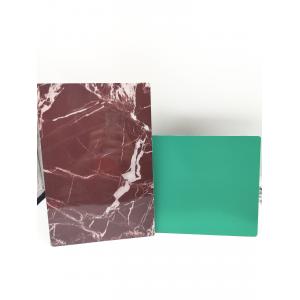
Add to Cart
Aluminum-plastic panels are flat panels composed of a non-aluminum core sandwiched by two aluminum sheets. They are robust and lightweight, making them suitable for architectural purposes as well as advertising signboards, shop facades and interior decorations.
Moreover, aluminum composite panels are capable of being recycled and are energy-efficient; thus, they meet the criteria of modern sustainable materials.
Featherweight: Aluminum composite panels have an impressive strength-to-weight ratio, with similar stiffness to aluminum sheets but only 60% of its areal weight and 30% of a steel sheet. Its lightweight quality makes it a perfect choice for exterior buildings decorations.
Exceptional Cohesion: With greater 180° peel strength and resistance to separation between the aluminum sheet and the plastic core material over long-term use, aluminum composite panels have superior cohesion power.
Weather Endurance: With excellent outdoor resistance, there will be no color alteration, shedding of coating, and its average life expectancy goes beyond twenty years.
Resistance to Corrosion: The service layer features high adhesion strength and is capable of preventing the corrosion caused by acids, bases and salt sprays. The PVDF fluorocarbon resin coating is also exceptionally resilient.
Withstands Wind Load: Not only does it withstand the wind load requirements for tall building exterior decorations, its performance level reaches the national A grade.
Flame-Proof: Its interior core is made up of non-toxic polyethylene, and sealed on both sides with thin, non-inflammable aluminum plates. It has been assessed in accordance with the fire protection classification of the state.

External Architecture: It is widely used for constructing external features on skyscrapers, standalone residences, business offices, as well as commercial buildings.
Inner Decoration: People are utilizing it in interior decoration for households, office spaces, and commercial areas. It includes wall accents, ceiling schemes, and room dividers.
Promotional Displays: This material is also put into use for billboards, store signage, direction indicators, digital advertisements, and display stages.
Transit Infrastructure: It is involved in the formation of additional components for buses, trains, metro systems, airplanes, and nautical vehicles.
Interior Design: Likewise, it is used for crafting furniture styles, wardrobes, kitchen cabinet faces, and other indoor installations.
Industrial Implementations: It is incorporated in industrial facilities, covering machinery, protecting equipment, and being used in sterile room.
Consumer Facing Designs: The properties of this material have allowed it to be applied in the design of retail stores, kiosk layouts, and indoor display segments.